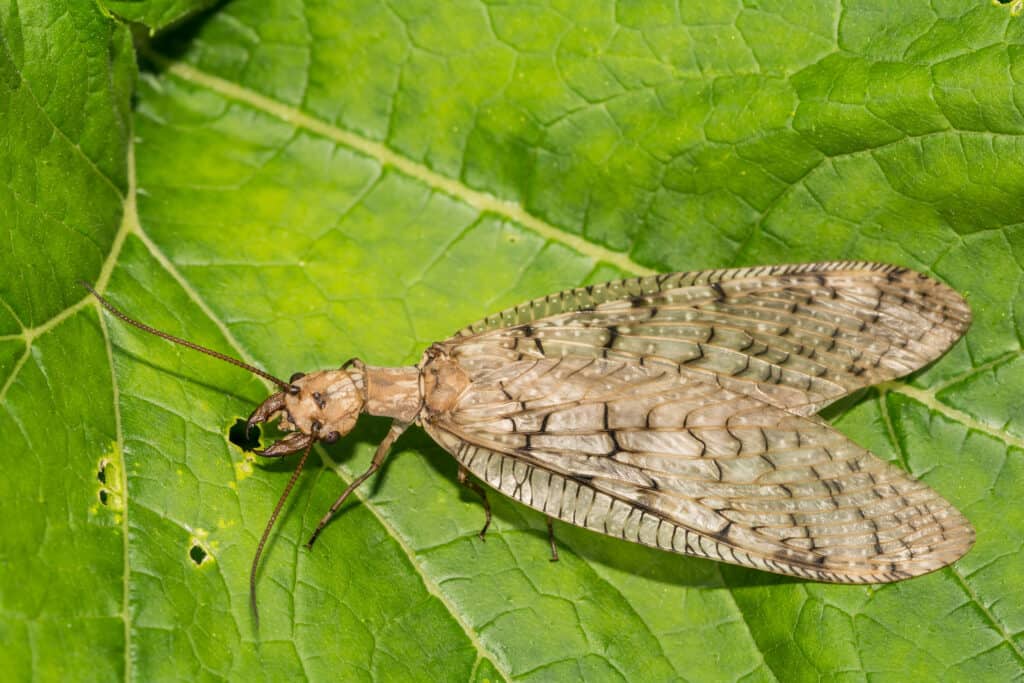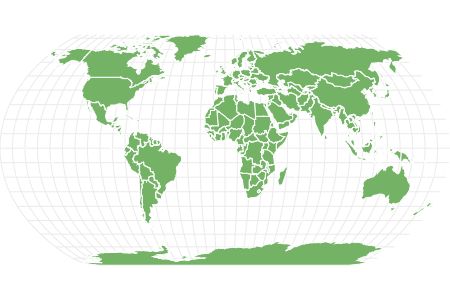Eastern Dobsonfly
Corydalus cornutus
They are quite vicious and, when provoked, will administer a painful bite that stings for a long time.
Advertisement
Eastern Dobsonfly Scientific Classification
- Kingdom
- Animalia
- Phylum
- Arthropoda
- Class
- Insecta
- Order
- Megaloptera
- Family
- Corydalidae
- Genus
- Corydalus
- Scientific Name
- Corydalus cornutus
Read our Complete Guide to Classification of Animals.
Eastern Dobsonfly Conservation Status
Eastern Dobsonfly Facts
- Prey
- Aquatic insects and small fish
- Name Of Young
- Larvae
- Group Behavior
- Infestation
- Fun Fact
- They are quite vicious and, when provoked, will administer a painful bite that stings for a long time.
- Biggest Threat
- Habitat loss
- Most Distinctive Feature
- Large mandibles
- Habitat
- Freshwater bodies that have high concentrations of dissolved oxygen
- Predators
- Fish, birds, and bats
- Diet
- Carnivore
- Lifestyle
- Nocturnal
- Common Name
- Eastern Dobsonfly
- Number Of Species
- 29
- Location
- North America
Eastern Dobsonfly Physical Characteristics
- Color
- Brown
- Yellow
- Black
- Tan
- Orange
- Lifespan
- Adults live between 2 to 10 days
- Length
- 2 to 3 inches
- Aggression
- Medium
View all of the Eastern Dobsonfly images!
The eastern dobsonfly is not actually a fly but a large winged insect with protruding mandibles. People usually see them near street lamps. They are helplessly attracted to lights and are nocturnal creatures.
They are quite vicious and, when provoked, will administer a painful bite that stings for a long time. These insects have a life cycle that is divided into four stages, and the entire process is named ELPA, which stands for egg, larva, pupa, and adult. The eastern dobsonfly’s larva stage lasts longer than the adult phase.
These insects are soft-bodied and vary in color from dark brown to yellow. In addition, they have translucent wings; however, sometimes, their wings have a gray shading.
Eastern Dobsonfly Species, Types, and Scientific Name
While there are 30 species of dobsonflies, only one occurs in the United States, the eastern dobsonfly. Other continents that are home to dobsonflies are:
- Africa
- Asia
- Australia
The eastern dobsonfly’s scientific name is Corydalus cornutus, and they belong to the order Megaloptera. This order is relatively small, consisting of only alderfly and dobsonfly species, and their most common traits are large, soft, and fragile bodies. In addition, they have aquatic larvae.
Interestingly, adult alderflies aren’t strong fliers. They have two sets of membranous wings almost identical in size; however, the hindwing is slightly wider because of a big folded area. As a result, they look similar, but most of the hindwing is hidden by the forewing.
In addition, they have large protruding eyes, chewing mouth parts, and segmented antennae, and males have longer and more prominent mandibles.
Eastern dobsonflies belong to the family Corydalidae, which consists of various species and 12 genera of fishflies and dobsonflies. These insects occur mainly in temperate and tropical climates throughout the Northern Hemisphere and South America.
Appearance: How To Identify the Eastern Dobsonfly

With two sets of broad wings twice the length of their bodies, eastern dobsonflies are large insects.
©Jay Ondreicka/Shutterstock.com
The eastern dobsonfly is a large insect with protruding mandibles and two sets of broad wings. In fact, their wings are twice the length of their bodies. In addition, they have two antennae on their heads and chewing mouthparts. Their mandibles are sickle-shaped and sharp enough to draw blood.
Females lay their eggs at multiple sites; they resemble tiny gray cylinders and look like white chalky masses when grouped together.
When the larvae hatch, they resemble centipedes because their bodies are flat and vary in color from brown, black, and tan. The larvae are aquatic and can grow between 2 to 3 inches in length. In addition, they have 6 legs and what looks like 6 to 8 gills called filaments that help them breathe underwater. They use their strong pinching mouthparts when feeding.
They are yellowish orange and covered in dark spots during their pupal stage. Once they have transformed into adults, they are soft-bodied, and their color can vary from dark brown to yellow, with translucent membranous wings that sometimes have gray shading.
Habitat: Where to Find the Eastern Dobsonfly
Eastern dobsonflies prefer habitats with freshwater bodies that have high concentrations of dissolved oxygen. This includes lakes, ponds, streams, and rivers where they lay their eggs.
Diet: What Does the Eastern Dobsonfly Eat?
When the eastern dobsonfly is in its larval stage, it is an opportunistic predator that feeds on anything within its surroundings; this includes prey like aquatic insects and small fish. Adults are not known to eat since they acquire all their nourishment in their larval stage.
Adults generally don’t live longer than a couple of days to a week, so they use this short time to concentrate on reproducing.
Life Cycle of the Eastern Dobsonfly
Females dobsonflies will lay their eggs in masses on structures near flowing water, like leaves or rocks near the water’s edge. Their white appearance is due to a substance that covers the eggs to protect them from overheating.
The eastern dobsonfly eggs hatch during the night, and the larvae will crawl or fall into the water and scatter. While they have four stages of development, the larval phase is divided into ten to twelve stages which can take 1 to 3 years to complete.
Although they spend their larval stage in water, their pupal phase occurs on land close to the body of water they came from.
Before entering their pupal stage, they will burrow into moist soil creating small cells, where they will stay for a week to two weeks before emerging as adults. Adult males generally live for a couple of days, while adult females can live up to 10 days old.
Is the Eastern Dobsobfly Dangerous to Humans?
One of the eastern dobsonflies’ most distinguishing features is their sharp, enlarged mandibles or “pincers.” The males’ mandibles are much larger than the females; however, it’s the females that bite, and their short, pointy pincers can really hurt humans.
While they are not poisonous, their bite feels like a painful sting that can irritate the skin for a few days. Although they used their mandibles as a defense mechanism to keep predators at bay, their true purpose is actually for mating. The males use them when fighting for a mate. Both genders will spread their jaws in a defensive motion if attacked or threatened.
Prevention: How to Get Rid of the Eastern Dobsonfly
One of the easiest ways to deter eastern dobsonflies is by changing or reducing the light in your home because they are so drawn to incandescent and bright white light. This is especially important if you live in areas with high infestations.
To prevent these insects from plaguing your home, you can try one of these foolproof methods:
- Reducing the amount of light used in the house
- Changing your lights to yellow diffused bug light bulbs
- Using lights made from high-pressure sodium vapor
Similar Species
There are four species similar in appearance to the eastern dobsonfly; they include:
Fishflies
Fishflies are mainly found in North America. Their scientific name is Chauliodes rastricornis; Chauliodes stands for “remarkable tooth,” and rastricornis means “rake-horned.”
Despite their large bodies, they can fly thanks to their long wings. They are more predominant in the summer months and common throughout North America. Much like their cousins, the dobsonfly, the males have larger pincers, and their teeth look like combs. In addition, they can bite humans, which causes a terrible stinging sensation. However, this usually only lasts a few hours to a day and then disappears, and it won’t have any long-term effects.
Alderflies
Alderflies are generally found in the vegetation bordering aquatic habitats that their larvae require. While they are attracted to lights, their obsession is not as intense as the dobsonflies.
Their longest stage is the larval phase, as adults don’t live longer than a few days, just long enough for Alderflies to mate and lay eggs.
Stoneflies
The stonefly is often referred to as Plecoptera,’ it’s an aquatic insect, and there are 3,500 species found all over the world. However, they do not occur in Antarctica. What’s interesting about this insect is it is believed to be one of the oldest groups of Neoptera.
They are closely related to species found in the Permian geological and Carboniferous. In fact, true stonefly fossils have been found that are only slightly younger than their prehistoric cousins.
Owlflies
Owlflies are not easy on the eye; they have grotesque larvae that are ruthless predators, using leaf litter and trees as their hunting grounds.
Hunting is quite simple, all they do is wait for prey to walk straight into their large mandibles, and they seize them and drain all their body liquids, almost like a vampire. The adults are large and can be confused with dragonflies.
Related Insects…
View all 117 animals that start with EEastern Dobsonfly FAQs (Frequently Asked Questions)
What does a dobsonfly do?
They are quite vicious and, when provoked, will administer a painful bite that stings for a long time.
Are dobsonflies good?
While the adults don’t play a big role in their ecosystem because they don’t eat and only live a few days. The larvae contribute in a big way. They are pollinators, parasitoids, and predators. They play an important part in their ecosystems by controlling the numbers of other populations of aquatic invertebrates.
Are dobsonflies harmless?
While they are not poisonous, their bite feels like a painful sting that can irritate the skin for a few days.
Are dobsonflies native to North America?
While there are 30 species of Dobsonflies, only one occurs in the U.S., the Eastern Dobsonfly.
Thank you for reading! Have some feedback for us? Contact the AZ Animals editorial team.
Sources
- Extension Entomology / Accessed September 13, 2022
- Kidadl / Accessed September 13, 2022
- Wikipedia / Accessed September 13, 2022















